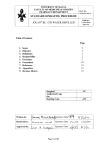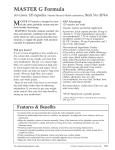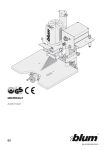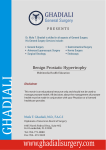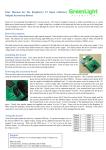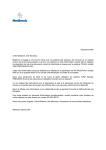Download Non-cancerous Prostate Problems
Transcript
Non-cancerous Prostate Problems Most men will have a degree of prostate enlargement as they get older. About half of the male population over 50 years of age will notice some alteration in their voiding pattern, and for about one third of them, it will be enough of a bother that they will want to do something about it. This is the process we know medically as Benign Prostatic Hypertrophy (BPH). It is not cancerous, but can have other effects on general health if not treated. What is the Prostate? The Prostate is the male gland which sits below the base of the bladder. The urethra, which the urine passes, runs through the prostate as shown in the diagram. The main valve which controls the flow of urine (the external sphincter) lies below the prostate and is left intact after the prostate operation (transurethral resection of the prostate). However, the bladder neck, which directs the flow of semen down the urethra, is removed by the operation. The main function of the prostate gland is to aid in the production of semen. It does not produce any hormones. The prostate makes about one third of the fluid that is ejaculated from the penis at time of orgasm. If surgery is selected, there will be no change in a man’s nature or character. The prostate gland is of no particular function in the elderly. In most men, beginning about the age of forty, there is a gradual enlargement of the prostate. This occurs to different degrees in different men. In some men the enlarging prostate squeezes on the channel carrying the urine to such an extent that it effects the passage of urine. In a few patients, the prostate gland shrinks and causes a contraction of the neck of the bladder. Prostate disease: Disease of the prostate refers to any medical problem affecting the prostate and includes: • • • Benign Prostatic Hyperplasia or hypertrophy (BPH) – this is non cancerous enlargement of the prostate Prostatitis – this is an inflammed prostate usually due to bacterial infection Prostate cancer – this is cancerous enlargement of the prostate within the prostate (localized) or outside the prostate (advanced). Refer to cancerous prostate section Why does benign prostatic hyperplasia (BPH) need treatment? Although many men have some symptoms of prostate disease, they are usually fairly minor and do not need active treatment. In approximately 25% of men the condition is serious enough to need treatment at some stage. Symptoms: This is the commonest indication (reason) for treatment. These symptoms include: • • • • • • • • • • A weak and poor stream Difficulty in starting or stopping the flow of urine Going to the toilet frequently An urgent need to pass urine Losing control of urine Not emptying the bladder completely Having to get up at night to pass urine Straining to urinate Painful urination Pain in between the scrotum and penis Lower urinary tract symptoms (LUTS) Lower urinary tract symptoms(LUTS) refer to a range of urinary symptoms linked with benign prostatic hyperplasia (BPH). The symptoms may be mild, moderate or severe and it is matter for each individual to decide if his symptoms are bothersome enough to require treatment (refer to IPPS). IPPS is a short questionnaire that helps determine how severe a patient’s bladder symptoms are. Although LUTS is often caused by BPH there are other reasons including prostate cancer, prostatitis, medications, neurological disease, spinal cord injury, strictures and infections. The effect of the blockage of the urine by the enlarging prostate varies from person to person. In some patients quite marked damage to the kidneys or bladder can occur. Incomplete bladder emptying may then produce urinary infections, bladder stones, or marked overactivity (sometimes producing incontinence) or underactivity (so that even after the operation the bladder doesn’t work properly). Of course, if these problems have occurred, or are likely to occur, treatment is needed, usually surgical. At times a complete blockage ( acute retention) of the urine occurs. This may occur with little warning, but usually the patient will have had prior symptoms as indicated above. When retention occurs a catheter is usually inserted. Experience shows that if retention has occurred, the best course is usually to proceed with an operation. It is important you discuss your symptoms with us so that we can investigate the problem, make the right diagnosis and arrange the most appropriate treatment/management. How is prostatic disease diagnosed? • • • • • • • • Description of symptoms Physical examination - a digital rectal examination(DRE) is the main test. This is where the doctor places a gloved finger in the back passage to check the size and shape the prostate and to feel for any other problems of the prostate. Blood test – Prostate Specific Antigen (PSA). PSA is a protein that is mainly made in the prostate and an elevated PSA may mean there is either an enlarged prostate, an infection or cancer. Other blood tests – urea and creatinine- check kidney function Urine tests – check for signs for infections or cancer Renal ultrasound – check the health of the kidneys and bladder Voiding flow rate and ultrasound residual -measures flow of urine and ultrasound residual checks what is left in the bladder following a void Urodynamics studies – pressure and flow relationship study – (refer to uodynamics section) What are the treatment options? • • Medications Surgery: Transurethral resection fo the prostate (TURP), Greenlight Laser, Transurethral incision of the prostate (TUIP), Open or retropubic prostatectomy Medications: A number of drugs are also used. The first group are alpha blockers and are derivaties of blood pressure medications. The original was prasozin (Minipress or Pressin). This is still used as it is cheap, but it does lower blood pressure significantly and that can be a real problem. More recently Flomaxtra is prescribed as it appears to improve prostatic obstruction more, with less side-effects. Although fairly expensive for long term use, some patients are quite happily using it. This group of medications can alleviate symptoms but does not fix the underlying problem. They also tend to lose their effect over time. The second main type of drug are 5-alpha reductase inhibitors which lower male hormone levels within the prostate (testosterone). The available drugs for this group in Australia are finasteride (Proscar) or dutasteriede (Avodart, Duodart). These medications actually shrink the prostate somewhat, but has not been particularly successful in improving the flow (about 15%). They work best with very large prostates, and are also useful in reducing the amount of bleeding from the prostate in various situations. Herbal treatments have been popular in some countries. Some seem to work, apparently in the same general way as Proscar, but not nearly as effective. We do not prescribe these herbal treatments. Surgery Transurethral Resection of the Prostate (TURP) The usual operation for benign prostate enlargement (BPH) is the Transurethral Resection of the Prostate (TURP). The immediate aim of the operation is to remove that inner part of the prostate (adenoma) which is pressing on the urethra. We do not attempt to remove the outer part of the prostate (the capsule) as this is a much more serious operation and is not necessary. Occasionally, just making a cut (incision) in the bladder neck is sufficient to relieve all problems. The operation is performed by the passage of an instrument along the penis and into the bladder, along the urethra. Thus it is called ‘Transurethral Resection of the Prostate’ or TURP. The instrument has a telescope and an electrical cutting attachment, a miniature TV camera is attached. The surgeon can see the prostate, and then removes the blocking portion piece by piece, as shown in the diagrams. This operation (the TURP) is fast, safe, relatively painless and usually only requires a hospital stay of a couple of days. There is no cut and no stitches. Diagram: Unfortunately, the TURP is not suitable for a few very large prostate glands, and occasionally we have to perform open surgery. This is called open or retropubic prostatectomy. This requires stitches and the patient is usually in hospital for several days longer. It is important to understand that these operations are not designed to treat Prostate Cancer. If we are trying to cure prostate cancer, we do a different type of operation called a Radical Prostatectomy (refer to cancerous section of the prostate). It is a much bigger procedure that the TURP, removing the capsule and adenoma together and has more potential side effects. Anaesthetic Modern anaesthetics are very safe. Usually you will have a spinal anaesthetic, where after having an injection in the back, you become numb from the waist down. The spinal anaesthetic provides excellent operating conditions. Most patients have some form of sedation as well, so they are not upset or frightened b y what is happening. As well as being very safe, the spinal anaethetic allows you to have a cup of tea as soon as you get back to your ward. For a variety of different reasons, the anaesthetist may recommend a general anaesthetic (particularly for people who have had prior back problems). You will have an injection in the arm and go to sleep. Nowadays, the time it takes to wake up after the operation is much less that in the years gone by. Intra-Operative Antibiotics It is standard practice to administer a single dose of a broad spectrum antibiotic during the procedure. Medication It is important that you tell you urologist of any medications you are taking. This includes any that your doctor has prescribed, as well as any you have purchased for yourself. Warfarin, Asprin and other anti-platelet drugs such as Plavix, Iscover or Prodaxa may cause significant bleeding during the TURP. We generally ask patients to cease taking Aspirin and the other anti platelet drugs one week prior to prostate surgery, and restart it about a week after the operation as long as there is not too much bleeding. If you have been taking Aspirin, please tell us! Some arthritic medicines also promote bleeding but are not as much of a problem as aspirin. Many of our patients now take these medicines and operating on a ‘bleeder’ can been quite difficult, requiring careful consultation with GP’s, cardiologists and anaesthetists for each individual. The advent of the Green Light Laser (refer to Greenlight laser section) which allows us to operate on patients who are still taking blood thinning medicines has thus been a major step forward. What happens after the operation? In hospital; Catheter and bladder washout: After the operation there is a raw surface left inside the prostate. Because this bleeds a catheter (tube) is left in the bladder (via the penis) to drain away the blood and urine. In the post operative stage the bleeding may be heavy and clots can form and block the catheter. Thus a bladder washout is used to wash the blood away before clots form. This means that there are extra bags of clear fluid hanging near the end of your bed. The amount of blood in the catheter gradually gets less and the washout is usually stopped on the day following surgery. By this stage you can usually drink enough fluid to keep the urine free of clots. The catheter is usually removed on the first or second day after surgery. This is quite a simple and painless process. The nurse removes water from the balloon on the end of the catheter, when all water is out of the balloon, the catheter slides out. Intravenous fluids Most patients have an intravenous drip in their arm for a day after the operation. This may be used to give medicines or fluids, but it just a precautionary measure in most cases. Eating and Drinking You will probably be able to eat and drink on the night after the operation. As soon as possible we would like you to begin drinking a large amount of fluid. This is the single most important thing you can do to hasten your own recovery. Bowels It is most important to keep the bowels as regular as possible. If you become constipated you will have to strain and this often causes the prostate to bleed more. It is important you eat a high fibre diet with adequate fluids before and after your surgery. If you require assistance with management of this please contact the Practice Nurse. Bladder spasms While the catheter is in, you do not have to pass urine yourself, the catheter will carry it away. Often it feels as though you have a full bladder, but this is usually just a ‘bladder spasm’, where the catheter irritates an overactive bladder. If you get this feeling, the nurse will check to ensure that the bladder is not full with a bladder scanner. If not blocked these spasms, although uncomfortable, are harmless and should not worry you. If they are painful, medicine can be given to reduce them. When the catheter is removed The day the catheter is taken out is often a worrying time. Many patients notice some scalding initially, and also some difficulty controlling the flow of urine. The most common problem is for the flow of urine to start with little warning, therefore, it is wise not to try to hold back the urine at first, but to go to the toilet immediately. The nurses will usually ask you to pass your urine into a urinal (‘bottle’) so that it can be measured, tested and recorded. The nurse will then check how well you have emptied your bladder using the bladder scanner. We try to collect a urine specimen on the day the catheter is removed, mainly to check for infection. As most men are being discharged from hospital within 24 hours of catheter removal the result will not usually be available until after you have left the hospital. If there is a problem we will contact you. At home; Discomfort and urgency You will usually go home the day the catheter is removed or the next day. Most men notice some discomfort when urinating. This is often felt at the tip of the penis. Pain that continues after urinating, producing a sensation that the bladder hasn’t emptied, may also occur. These are normal and usually disappear after a week or so. Many men have quite marked urgency, that is having to rush to the toilet. This is because the bladder has become overactive from straining to empty prior to surgery. This urgency gradually settles and may take a few weeks, although in some men it may take several months. If urgency is a particular problem, there are medications which can help. Bleeding The raw surface of the prostate takes about six weeks to heal completely. You may pass some blood in the urine, particularly in the first or second week after you go home. Do not worry about this. If the urine gets blood stained then just drink some extra fluid to wash it out. However, if bleeding becomes heavier, especially if you are passing clots or if you are unable to pass any urine, contact the Practice rooms or your urologist immediately. Fluids It is wise to continue to drink extra fluids for a few weeks following the procedure, particularly, if you see any blood appearing in the urine. Activity You should usually stay indoors for a week or so after discharge. It is usually wise not to drive a car for a couple of weeks. Do not indulge in any strenuous activity for four weeks. Avoid heavy lifting, gardening and golf. Refrain from horse riding, motor cycle or bicycle riding. You may return to work after four weeks unless you have a heavy manual job, where it is wise to wait an extra two weeks. Bowels It is important to keep the bowels soft and regular. A high fibre diet incorporating Bran often helps. Continence Most patients have excellent control of their bladder when they leave hospital, There are a few who still have some problems controlling the flow of urine. This is usually due to damage already done to the bladder by the prostatic obstruction. With time, all such cases improve. Permanent loss of continence is a very rare complication of TURP. Some men who have presented with retention may have trouble passing urine or emptying their bladders completely after the operation. This occurs because the bladder has been overstretched and becomes weak. These patients may require a period of indwelling or intermittent catheterization at home while their bladders recover. Sexual function Many men are concerned that a prostate operation will end their sex lives. However, with today’s techniques this is very uncommon. The only difference is that after the operation, there is no emission with ejaculation (nothing comes out). This is due to the removal of the bladder neck. This means semen passes backwards into the bladder during ejaculation and you may note that the urine you pass after intercourse appears a little cloudy. This is nothing to worry about as the fluid will do no harm. The ability to maintain an erection is nearly always retained and sexual intercourse can be resumed a few weeks after surgery. Patients often say that their sensation of orgasm is not as strong as it was before the operation. New Technology GreenLight Laser Many attempts have been made to destroy prostatic tissue by heating it, rather than cutting it out. This is known as ‘ablation’ of the prostate. One very effective way of heating prostate tissue is with a Laser, and Laser Ablation of the Prostate. Recently, we have started using a Green Light Laser, which actually provides so much energy that the prostate tissue is vapourised (turned into gas bubbles). This produces excellent results. The GreenLight Laser usually needs less hospital time than traditional prostate surgery and involves less bleeding. The reduction in blood loss is so significant that we are very actively recommending the Green Light Laser for our patients who are on anticoagulants (blood thinning medications). It is not yet clear whether the improvement in urinating will endure as long as a standard TURP, but the early results are very promising. What is the Greenlight Laser? The Green Light Laser is a new, highly effective alternative to traditional TURP, which has been the ‘Gold Standard’ for many years. The procedure is performed with a small fibre that is inserted into the urethra through a cystoscope. The fibre delivers high powered laser energy which quickly heats up the prostate tissue causing it to vaporize. This continues until all prostate adenoma has been removed. Natural urine flow rapidly restored and urinary symptoms are quickly relieved in most patients. The major advantages of the Green Light Laser treatment is that it is less invasive, with less blood loss, usually shorter hospital stay and faster return to work. It is particularly useful for the more elderly man with other medical problems. The Green Light Laser treatment is particularly useful for those patients who take anti-coagulants )blood thinning medicines such as aspirin, warfarin, Plavix or Iscover), and who would be at risk if they stopped those medicines. We are usually able to carry out the procedure, effectively treating their prostate enlargement without the risks of bleeding or stopping the anticoagulants. We use the GreenLight Laser at Warringal Private Hospital and Northpark Private Hospital where there is usually no extra charge to health fund rebates. What are the advantages of Greenlight Laser? • • • • • • • Rapid urine flow improvement Quick return to normal activities Virtually bloodless procedure A definitive, long lasting treatment Less that 1% reported cases of erectile dysfunction Short to possibly no catheterization (less that 24 hours in most cases) Over 375,000 patients treated worldwide What happens during the Green Light Laser Procedure? First the Urologist will perform an evaluation to see if you are a candidate for this treatment. Then, on the day of your procedure, you will come to the day surgery. You should make arrangements to have someone drive you home since this is a surgical procedure. In some cases, you may be required to stay overnight. The surgeon will determine this. Each patient is different, therefore treatment procedures may vary. Below is a description of the procedure and what to expect. 1. Before treatment, your Urologist may give you a medication to help you relax during the procedure. Other medications may be given to you to avoid infections. 2. You will be brought into the operating theatre and moved onto a trolley where you will lie on your back. You will be given a general anaesthetic that will 3. 4. 5. 6. allow you to sleep through the entire procedure. Occasionally, other types types of anaesthesia may be used mainly a spinal shock. Once you are asleep or the anaesthesia block takes effect, your urologist will insert a cystoscope through the urethra. The laser fibre is introduced through the cystoscope and advanced into the urethra at the location of the prostate. The urologist systemically vaporizes the enlarged prostate tissue until the obstruction is removed. At the end of the procedure the urologist will place a temporary catheter to let urine drain from your bladder. What happens after Greenlight Laser procedure? If a catheter was placed in your bladder at the end of the procedure, it will typically be removed in the morning. Patients usually pass their urine promptly following catheter removal. The nurse will check to ensure the bladder is empty using the bladder scanner and if satisfactory, they will be discharged later that day. If, however, there is ongoing bleeding or the patient is not continent, then they will not be discharged Patients with compromised bladder function or those who have required prolonged catheterization as a result of severe urinary symptoms may require a catheter for a longer period of time. You must make arrangements to have someone drive you home. Most patients experience very rapid relief of symptoms and a dramatic improvement in urine flow. This typically occurs within 24 hours of the procedure. However, medical history, health condition and other factors can influence treatment recovery. You may experience mild discomfort such as slight burning during urination and small amounts of blood in you urine for a week or so. Also, depending on the condition of your bladder, you may experience greater frequency and urge to urinate. This will resolve over time as your bladder adjusts now that the obstruction in your urethra has been removed. Can Prostate Problems recur? Occasionally they can. Symptoms may recur in the early postoperative phase if scar tissue develops and encircles the urethra or bladder neck. If a ‘Bladder Neck Stenosis’ develops, it requires another minor procedure to release it. The other type of scar tissue is known as ‘urethral stricture’ is generally fairly easy to treat, but may at times require further surgery. The prostate can grow back to some extent. This usually takes many years if the operation was for a non-cancerous condition. You will probably be asked to come back to see you r urologist once or twice after the operation, but if you have urinary problems develop after that, ask you local doctor to arrange another appointment. Prostate Cancer or Prostate Enlargement? This section has been about benign (i.e. non cancerous) prostatic enlargement. Although a small proportion of men who have prostatic problems do have cancer in their prostate glands, we do not generally recommend a TURP to treat it. Treatment of prostate cancer is usually quite different to the treatment of benign prostate complaints. During the routine tests you have prior to the operation the presence of a cancer would be changed. If you are worried about cancer do not hesitate to ask. We will not conceal anything from you. Most patients will have a PSA test during pre-operative evaluation. This is a very sensitive test for prostate cancer, but unfortunately it only shows up positive in certain other conditions (including benign prostatic enlargement!). Small areas of dormant prostate cancer are found in about 10% of older men. They do not usually require treatment if found by the pathologist. There are some cases where an active cancer does not show up on the tests prior to the operation, and is only found by the pathologist when he makes the routine check of the tissue we remove. If this happens you will be told of it and further tests and perhaps treatment begun. We find that many men are very worried about prostate cancer than have it, so don’t be afraid to ask!















